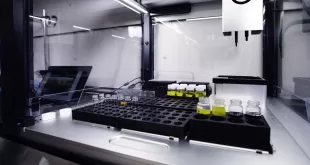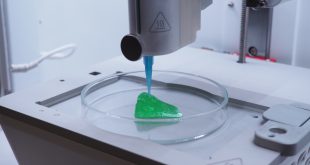By Sean Tarry
The past couple of years have been disruptive and chaotic, to say the least. Communities all over the world have been impacted by the COVID-19 global pandemic, changing the way we do things, share information, and communicate with one another.
For scientists working in laboratories that specialize in researching and tracking infectious diseases, it’s been a time that has served to propel our collective knowledge concerning their spread and impact on humans. Leading the way in Canada with respect to the study and diagnosis of many of the world’s most dangerous pathogens is the country’s National Microbiology Laboratory (NML) in Winnipeg. Formed in 1999, the NML is a hub for research within the country and is responsible for Canadian public health, health emergency preparedness and response, and infectious and chronic disease control and prevention. And, according to NML Vice-President Guillaume Poliquin, it does so through the execution of work within a number of key areas.
“Where the Lab really excels in supporting the Canadian public health system is in the diagnostics and reference work that we do around diseases that are difficult to diagnose, rare, or cumbersome,” he says.
“However, we’re also constantly studying some of the more commonly diagnosed diseases as well, like streptococcus pneumonia, in order to better understand how they change and evolve over time, taking data in from across the country, doing the appropriate laboratory work and then feeding that information to people who make the downstream decisions. Technology continues to advance, and pathogens are ever-changing, driving our need for strong research and development to consistently remain ahead of our work. We provide a leadership role within the Canadian Public Health Laboratory Network, collaborating and exchanging knowledge with the country’s public health network. And we also work with global groups, contributing our expertise and know-how with respect to understanding threats on a global scale.”
Understanding COVID-19
Not surprisingly, much of the work that the laboratory is undergoing at the moment is focused on tracking and researching COVID-19, spanning the development of new diagnostics and the evaluation of things like rapid antigen tests to the studying of potential vaccines for the virus. The work that its scientists and technicians do on a daily basis is extraordinary, helping to further our comprehension and awareness of the disease. However, in between the aforementioned efforts there are a handful of initiatives that Poliquin says the NML is especially proud of that has the potential to change the way COVID is tracked, diagnosed, and treated.
“The development of our wastewater initiative, which is focused on the monitoring of wastewater to better understand transmission of COVID at a community level, has been essential in informing and directing public health officials with respect to the presence of the virus and its variants,” he says.
“We’re also very proud of our Northern Remote and Indigenous Initiative, which was driven by a need at the onset of the pandemic to speed up testing in remote areas. Working in partnership with more than 350 remote and First Nations communities across the country, we’ve been able to develop and set up in-community testing systems that allow people to access critical testing in a timely manner, really helping to set up the future for in-community diagnostics to take place for other diseases. And our genomics initiative, which is being used to heighten our national understanding of the variants, is serving a critical role in observing their evolution in real time.”
A range of pathogen work
In addition to these projects, the NML is also heavily invested in the study of a range of viral diseases, such as hepatitis and other blood-borne pathogens; other respiratory viruses and viral exanthemata, such as measles; bacterial pathogens, including tuberculosis and antibiotic-resistant organisms; and enteric diseases, with a focus on food and water-borne pathogens including E. coli and salmonella. In fact, the NML’s Canadian Science Centre for Human and Animal Health—one of its several sites located across the country—is also home to the Canadian Food Inspection Agency’s National Centre for Foreign Animal Disease, allowing scientists to freely share research and information. In addition, the Lab also conducts extensive research around some of the world’s deadliest pathogens like Ebola, Nipah, and Marburg. As such, it operates the only laboratory in Canada equipped to conduct high-containment work. Such work harbours risk, admits Poliquin, but is work that he says the NML approaches with extreme seriousness from a health and safety perspective.
“We understand that we’ve been entrusted to be able to leverage the resources and know-how to work with some of the world’s deadliest pathogens, and we take that honour and responsibility incredibly seriously with respect to safety,” he said.
“Safety at the Lab is indexed concerning all sorts of layers of protection. As our work progresses up the four containment risk groups, extra layers of protection and training are required from technicians, ranging from the use of lab coats and hoods and the use of respirators and showers, all the way up to Level Four work which involves a fully enclosed environment in which technicians have their own air hoses that are separate from the air inside of the lab. In addition to the layers of protection and training that’s necessary, we also place a great amount of emphasis around decontamination protocol research, with an entire group that’s responsible for fwurther ensuring the safety of the lab and the continual adherence to and evolution of lab safety protocols.”
People, partnerships and collaboration
Just as important as the work that the NML conducts and the layers of safety that it ensures is the talented and dedicated team of scientists and technicians that make it all happen. It’s a team, explains Poliquin, that has grown exponentially as a result of the pandemic and efforts that have been required in order to properly and accurately track and research the virus.
Prior to the outbreak, the Lab operated with approximately 550 staff. Today, there are more than 800 science professionals working toward the NML’s goals and objectives. Most of the funding that it receives in order to support its efforts comes through the Public Health Agency of Canada. And the Lab also partners with various other government departments on a number of initiatives, including collaborations with the National Research Council and the Canadian Institutes of Health Research.
It’s a collective effort that Poliquin says guides the Lab’s work, adding it’s the only way innovation of this kind of significance is truly achieved.
“Fundamentally, science is not a solo endeavour, particularly not in this day and age,” he said.
“In light of this, we curate and encourage our staff to collaborate with academia where there are mutual interests. In doing so, our reach and knowledge is naturally extended through these types of partnerships and collaborations. As part of this, international collaboration is also essential to the work that we do and to the work being conducted around the world. We’ve had deployments in which we’ve supported Ebola diagnostics in Congo and the Lassa virus in West Africa. We recognize that pathogens do not respect borders and have seen that in crystal-clear relief with this current pandemic. Our view is that improving diagnostics capacity and knowledge abroad will make us safer at home, allowing us to fulfill our responsibility as an internationally active institution to be a good global citizen.”
The power of data
It’s a comprehensive portfolio of ongoing work that’s no doubt impressive. The amount of collaboration between team members and with members of other organizations, the assembly and organization of research and information, and its dissemination and analysis, requires an enormous amount of effort, as well as a seemingly perfect confluence of technological innovation and human insights. And facilitating this amalgam is the power of data. Without it, says Poliquin, much of the work that the laboratory conducts would be impossible or, in the least, incredibly consuming from a human capital perspective, adding that it’s in large part responsible for the enabling of the NML’s ability to carry out such incredible production and performance.
“Data complexity continues to increase,” he says. “Our network handles an astounding amount of sheer data on a daily basis which really goes a long way toward supporting the work that we do. It’s data that’s integral to our ongoing research and diagnostics. As such, we’ve invested significantly in bringing in the knowledge necessary to not only generate and handle that volume of data, but to be able to conduct the analytics as well. And we’ve also put a lot of focus on figuring out how we make all of our data available in a useful and responsible manner, so we not only benefit within the laboratory, but that the benefit of the data is extended through our numerous partnerships with academia and others. The power inherent in the data is increasing every day. And its importance with respect to the work of microbiology scientists all over the world is only going to continue increasing, too.”
Comprehending the future
The complexity of the work that the NML is responsible for, combined with its critical nature concerning the continued health and safety of Canadians across the country, is almost overwhelming. And, given the world’s present circumstances, it might just be some of the most important work being done at the moment. Their efforts have lent toward an improved understanding of the COVID-19 virus and its variants, serving to lessen the severity of the pandemic’s impacts and lightening the tenor of a very dark time in human history.
And, although Poliquin acknowledges these obvious trials and tribulations, he suggests that, looking forward from a scientific research and pathogen diagnostic point of view, the past two years may have served to benefit humankind more than we can currently imagine.
“There haven’t been a lot of silver linings with respect to the pandemic, but there are a few if you look closely enough,” he said.
“There’s been a leapfrog forward in our ability to use tools like genomics and wastewater diagnostics that have been advanced as a result of the pandemic. One day, concerning the devastation that’s been caused by the virus, the storm will run out of rain. But there will be all of that know-how and infrastructure and all of that capacity that’s been built up. There isn’t a shortage of other infectious diseases that we’re going to need to consider and study going forward in order to get ahead of the next threat. So, how do we take the tools and the knowledge that we’ve developed and translate it to the best of our ability in order to keep Canadians even safer moving forward? That’s the question that we keep asking ourselves at NML, and one that continues to drive the entire team and the work we do forward.”
 BioLab Business Magazine Together, we reach farther into the Canadian Science community
BioLab Business Magazine Together, we reach farther into the Canadian Science community





